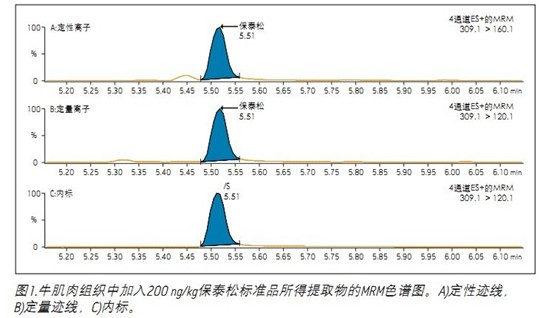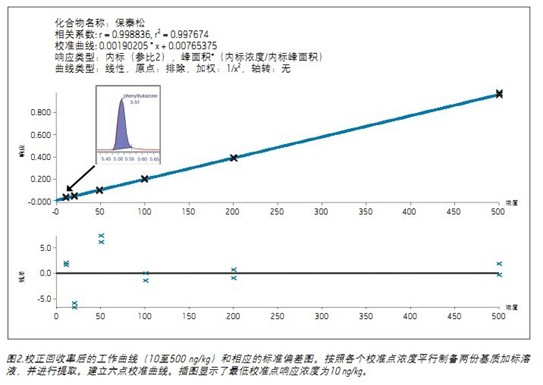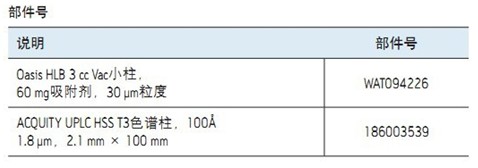Determination of phenylbutazone in animal-derived foods using ACQUITY UPLC I-Class and Xevo TQ-S
Claude Mallet
purpose
Rapid detection and quantification of low concentrations of phenylbutazone in muscle tissue using ultrasensitive UPLC ® -MS/MS.
background
Recent investigations have revealed that undeclared horse meat is found in beef products in Europe. This incident is urgently required by relevant companies and regulatory agencies for horse meat tissue and residual non-steroidal resistance in meat and meat products. The inflammatory drug (NSAID) phenylbutazone (PBZ) was analyzed and tested. PATENT is a veterinary drug used in some EU member states to relieve pain and reduce inflammation for non-food animals (dogs and horses). However, this drug is not prescribed for the treatment of animals involved in the human food chain. Therefore, the presence of this substance in any animal-derived food is usually caused by the illegal use of treated horse carcasses.
Ultra-sensitive UPLC-MS/MS methods are used to ensure detection of low concentrations of contaminated products.
solution
This study cites a reported method 1 for extracting phenylbutazone from muscle tissue and making minor adjustments to the method. Simply put, 2 g of meat homogenate was taken, 10 mL of acetonitrile was added, and shaken for 2 min. After centrifugation, the supernatant was collected and diluted with water. The diluted extract obtained in the first step was subjected to solid phase extraction (SPE) using Waters ® Oasis ® HLB 60 mg. The phenylbutazone was eluted with methanol and then diluted with water containing 10 mM ammonium formate (pH 3.2). The extracts were separately diluted prior to solid phase extraction and loading so that evaporation and reconstitution operations were not required. Take 100 μL of the diluted sample solution and inject it into the LC-MS/MS system for analysis.


Two multiple reaction monitoring (MRM) ion pairs (quantitative and confirmatory) were selected and optimized for the analysis of phenylbutazone. The obtained results have added to the Quanpedia TM database for future use. In this application, the chromatographic analysis was performed using a 2.1 x 100 mm HSS T3 analytical column (1.7 μm) eluting with methanol/water (10 mM ammonium formate, pH 3.2) with a gradient time of 5 min. Figure 1 shows the MRM chromatogram of the 200 ng/kg phenylbutazone spiked extract. As shown in Figure 1, the TB and internal standard (100 ng/kg) have high signal-to-noise ratio and good peak shape. The working standard curve after correcting the recovery rate is shown in Fig. 2. Two samples of the matrix spiked sample were prepared and extracted to establish a six-point calibration curve. Based on linear regression, a calibration curve (1/x 2 weighted) was calculated with phenylbutazone-diphenyl 13 C 12 as an internal standard. From the results data, it is easy to reach the minimum calibration point (10 ng/kg), which is 500 times lower than the EU recommended concentration (RC) of 5 μg/kg. The linearity was good (R 2 0.997) over the entire detection concentration range (10-500 ng/kg). In the process of processing meat products, horse meat may be incorporated by other means, and the concentration level of phenylbutazone may be much lower than EU RC, so detection sensitivity is an important consideration.
to sum up
The ACQUITY UPLC ® I-Class System is combined with the Xevo ® TQ-S and combined with the Waters ACQUITY UPLC HSS T3 column for the analysis of phenylbutazone in meat concentrations as low as 10 ng/kg. This ultra-sensitive UPLC-MS/MS technology ensures successful detection of contaminated products, even for mixed and processed meat products that may be low in concentration.
references
1. N. Van Hoof, K. De Wasch, S. Poelmans, H. Noppe and H. De Brabander Rapid Commun. Mass Spectrom. 2004; 18: 2823–2829

Corn Starch ,Corn Starch Heb,Bulk Corn Starch,Cornstarch Healthy
Shanghai J.Shine Co.,Ltd , https://www.jshinechem.com